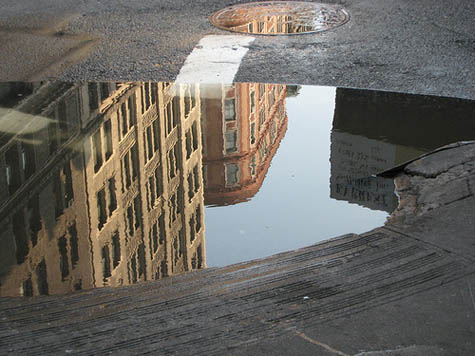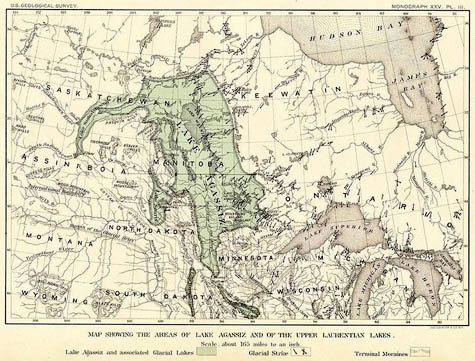Temporary lakes have sprung up all over Manhattan again this week, sometimes more than twenty feet wide and a foot deep, spanning curbs and pooling in gutters, the aquatic remains of last week's rain and snowmelt.  [Image: Photo by Flickr-user ShellyS].
[Image: Photo by Flickr-user ShellyS].
This surprise limnology—often demanding new, indirect lines of approach from one side of the street to the next—reminded me of David Gissen's recent, recommended book Subnature, which includes an entire chapter on urban puddles.
"Although we often think of puddles as inconsequential," Gissen writes, "they appear in architectural history in prominent ways—in drawings of ruins, photographs of decaying buildings, and experimental designs that attempt to use water in provocative ways." Now, however, "these stagnant pools of water, once signifying society's vulnerabilities, appear to have disappeared in much contemporary work"; indeed, he adds, contemporary architects have seemingly always "viewed stagnant water with suspicion." There is good medical reason for this suspicion, of course; indeed, the Centers for Disease Control advised last year that "neglected swimming pools"—i.e. stagnant bodies of water—are fast becoming vectors for mosquito-borne disease.
The CDC specifically cites "the adjustable rate mortgage and associated housing crises" as unexpected disease incubators: "Associated with home abandonment was the expanding number of neglected swimming pools, jacuzzis (hot tubs), and ornamental ponds. As chemicals deteriorated, invasive algal blooms created green swimming pools that were exploited rapidly by urban mosquitoes, thereby establishing a myriad of larval habitats within suburban neighborhoods," they wrote.
In any case, Gissen describes "visions of the undrainable city" as a kind of sickly counterpart to the modern, infrastructurally managed, rational metropolis, pointing out that "the waters inundating the modern city rained from above and surged from below." These overload our modern streets and sewers, bringing even 21st-century cities closer to the flooded Roman basements of Piranesi than to the hygienic visions of Le Corbusier, Gissen suggests. I'm reminded here of a disconcerting remark made by Alan Weisman in The World Without Us that the subways of New York City would be irreparably flooded within only 36 hours if the city's underground pumps ceased to function.
While reading Gissen's chapter on puddles, however, one of the first things that came to mind is that someone should produce a puddle map of New York—an urban atlas of temporary flooding. Set your parameters—puddles one foot deep by thirty-feet wide, say, or, more accurately, a volumetric guideline (at least one hundred square-feet of water or no less than 120 gallons)—and bring these fleeting aqueous forms into the geographic consciousness of the city.  [Image: A map of glacial Lake Agassiz].
[Image: A map of glacial Lake Agassiz].
From one rainy season to the next, an accelerated paleolimnology of New York thus comes into being; the Lake Lahontans and Lake Agassizs of the five boroughs are given their cartographic due. Here a tiny lake once stood, historical plaques could read, bringing to mind a liquid version of Taylor Square, the famed "smallest park" in Cambridge, Massachusetts.
What monstrous puddles have existed in your neighborhood, and how have the urban circumstances of their existence changed over time? Did curb-cuts or new drains eliminate these hydro-geographies—or even make them worse? And whose lives have been affected by these unmapped bodies of water, whether through hydroplaning, sidewalk splashes, or even an expensive pair of ruined shoes?
Whole personal histories of human contact with puddles, and the effects such exposure might have, could be produced or recorded. This is extraordinary: we live beside temporary lakes and inland seas in cities all over the planet, yet these landmarks never make it onto our maps.
Lưu trữ Blog
-
▼
2009
(1255)
-
▼
tháng 12
(126)
- Happy New Year Everybody
- Kakapo Artificial Insemination a 2009 Success
- Gott nytt år!
- It's the last day
- Art Trap
- Spiral Icon
- Inside Bubble Bobble
- Varför börja lagom när man kan börja med sällskap?
- Racing Year in Review
- Halsrapport
- Manhattan Paleolimnology
- En hals som förstör
- Kontraster
- Rousseau and Echolocation
- Harrietsham 10k
- Week Ending Dec. 27
- Re-shaping
- Sluggish and meandering
- Saltwood Boxing Day Run
- Playlist - 26th December 2009
- Snöigt
- Mystery of Amazon Manatee Migration Solved
- In Memoriam
- The Shining movie poster
- Min julafton
- Music for Landscapes
- God jul!
- Julen är här
- Merry Christmas and have a cup of Civet Poo!
- Jeez Louise and Thomas Sabo
- På plats i värmlandsskogen
- East Kent Sea and Countryside
- Merry voXelMas!
- Banana flavoured Cinnamon Chips Mmmm!
- Across the ocean
- Julledig!
- Stephen Fry on Operation Rhino
- The Ducks gave Cate the cold shoulder
- Leviathan: An Interview with Richard Mosse
- Geospatial Holograms
- En vit jul?
- Muscatatuck
- The Burj Dubai as Storm Machine
- Week Ending Dec 20
- Både bra och dåligt
- Crash State
- Dance and show us your miracles!
- Playlist - 19th December 2009
- Med solen i ögonen
- On Bombs and Preservation
- VIERNES
- A User's Guide to New York City pt. 2: Street Vend...
- A User's Guide to New York City pt. 1: Tenants' Ri...
- And the winners are!!!!
- Don't skip in Landstrasser-Hauptstrasse
- Technabob logo redesign
- Overweight
- Recent Site Change
- A PHOTO STORY BY REED + RADER
- An Ocea of calm
- Merry Christmas !
- THE FIRST DAYS OF SPRING - A FILM BY NOAH AND THE ...
- China, Iran, Myanmar, Australia
- CANDIE - POSITIVE MAGAZINE
- PHOTOGRAPHY OF GALA COLLETTE
- WASHED OUT - BELONG VIDEO
- PHOTOGRAPHY OF SANDY KIM
- Best New Blogs of 2009
- Love in the Time of Home Quarantine
- Pica-sso
- Napoleon did not have this much trouble!
- They might be Golden Crowned Hornswoggles
- Cracking the Planet
- Pirate Radio Speleology
- And a little child shall lead them (and my giveaway!)
- Christmas Classic 4 Miler
- Week Ending Dec 13
- Playlist - 12th December 2009 - Funkology
- HOT CHIP - ONE LIFE STAND
- ART OF COREY SMITH
- Editorial cartoons
- We would like to talk to you about the bible
- Northern White Rhinos Returning to Africa?
- Blog catchup time
- HEALTH LIVE VIDEOS AND INTERVIEW
- It's time to Butt Out
- Ninja christmas
- MEMORYHOUSE - TO THE LIGHTHOUSE
- CANDIE - STIMULUS RESPOND "SKIN"
- Eat the Earth
- PORTISHEAD - CHASE THE TEAR
- When a door closes
- TIMES NEW VIKING - BORN AGAIN REVISITED
- Get the Rat Hat ready
- Blackout
- Don't stand during the Messiah
- Make Mine a Minaret
- How To: Seed Grenade
- Welcome to the Sultans Suite
- Agenda
-
▼
tháng 12
(126)